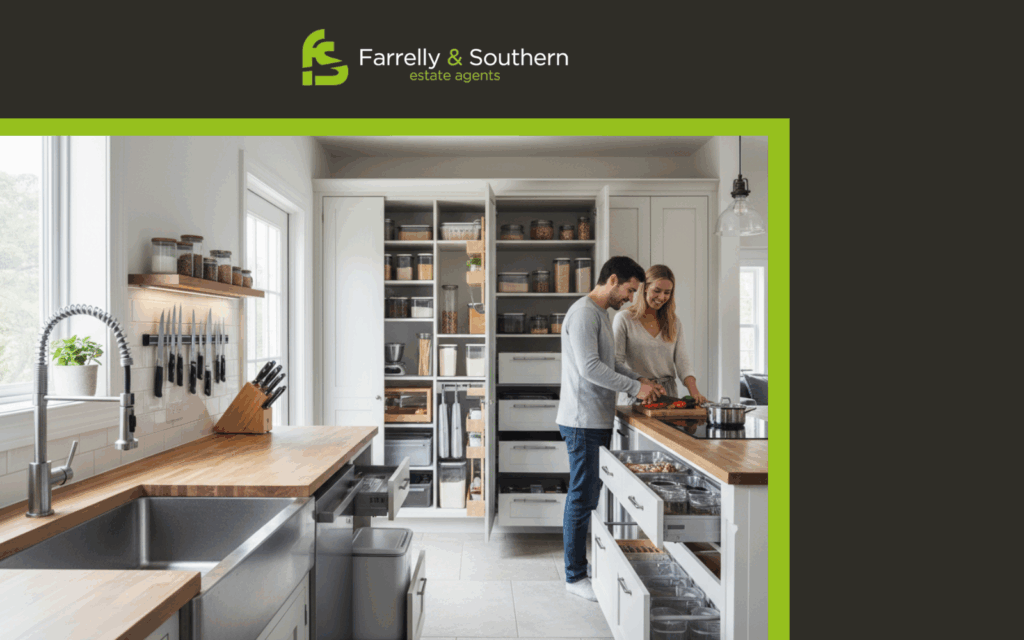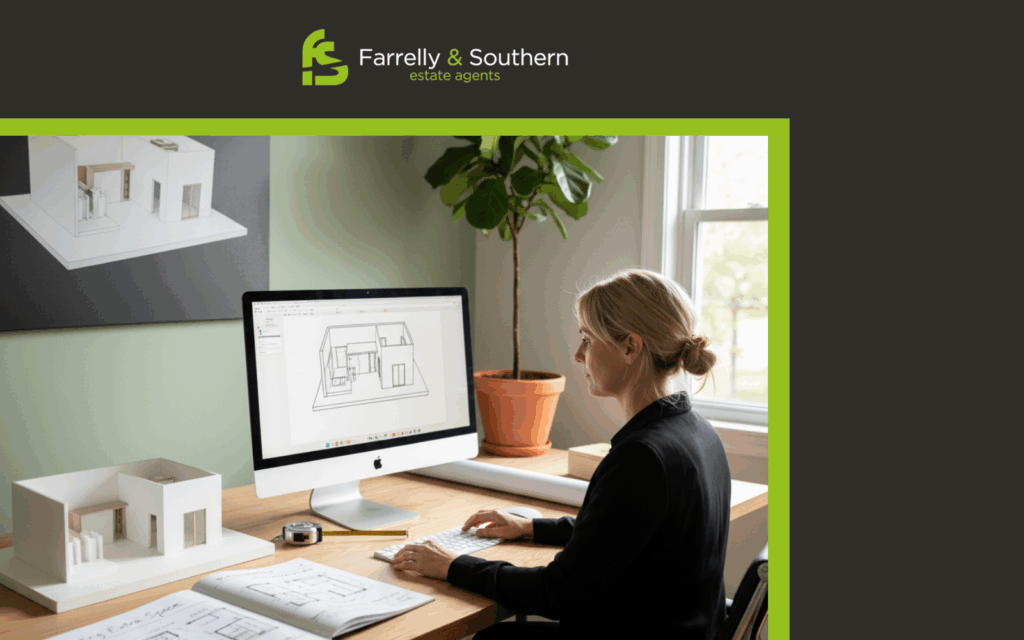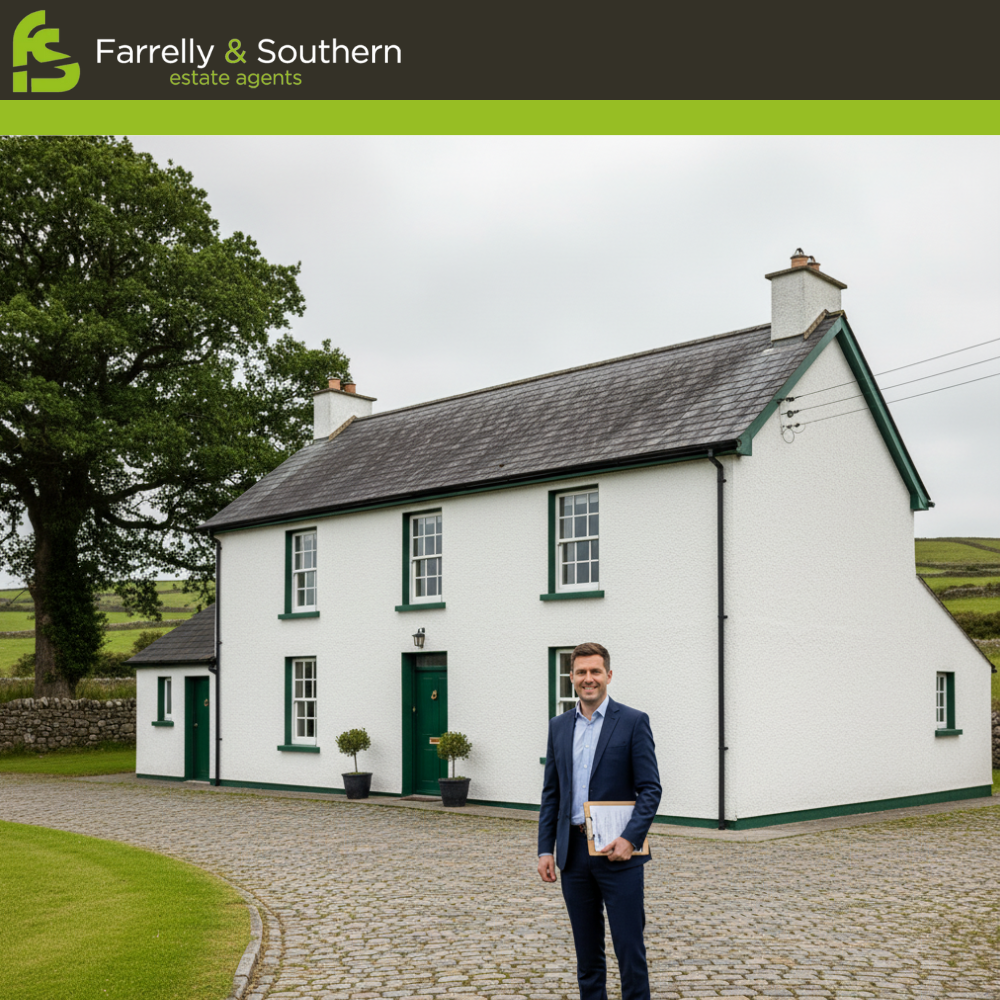
Planning to sell your home? Here’s the truth: you don’t need a massive budget to add value to your property. What you need is a clear strategy and an understanding of what actually matters to potential buyers in today’s market.
At Farrelly Southern, we’ve walked through hundreds of homes with sellers asking the same question: “What home improvements will actually increase property value?” Based on years of experience in the Irish market, we’ve seen what works—and what’s just a waste of money.
Let me share the realistic, tried-and-tested ways to increase the value of your home without breaking the bank.
Understanding What Actually Adds Value to Your Home
Before you spend a single euro, understand this: not all improvements add value equally. Some upgrades will help you attract buyers and achieve the best possible sale price. Others? They’ll drain your budget with little return on your investment.
The improvements you make should focus on what potential buyers are actively looking for. And right now, that’s homes that feel fresh, well-maintained, and move-in ready.
Start with Your Building Energy Rating (BER)
Your BER certificate is increasingly important to buyers, and for good reason. Energy costs aren’t going down, and buyers know it.
Think about upgrading insulation in your attic and walls first, because that’s where most homes lose heat. If you still have old windows, installing double glazing makes a massive difference to both energy efficiency and noise reduction. Replacing that ancient boiler with a modern system is another smart move that buyers genuinely care about. If your budget allows, adding solar panels can push your rating even higher and appeal to environmentally conscious buyers.
A home with a B rating will sell faster and for more money than an identical property with a D rating. It’s that simple. The SEAI offers grants for many of these improvements, so the actual cost is lower than you’d think.
Moving from a D to a B rating can add 5-10% to your market value. That’s potentially €20,000-€40,000 on a €400,000 home. When you consider the grants available, it’s one of the smartest investments you can make when preparing your home for sale.
Kitchen Improvements That Actually Work

Your kitchen matters because it’s where buyers imagine their daily life happening. But here’s what most sellers get wrong: you don’t need a complete remodel to increase the value.
If your kitchen is basically sound but looks dated, start by replacing worn cupboard doors rather than ripping everything out. It’s much cheaper than a full renovation and can transform the look of your kitchen completely. Update tired fixtures and hardware next, because new taps, handles, and drawer pulls make everything feel more modern. Install better lighting too—it makes a big difference to how the space feels and functions. Then deep clean everything until it’s genuinely spotless, and apply a fresh coat of paint in neutral colours to tie it all together.
If you’re doing a full kitchen renovation, yes, it’s expensive at €15,000-€30,000, but the look of your kitchen can really add value. Just make sure the style suits your property’s price point. Don’t install a luxury kitchen in a modest estate—you won’t get that money back. A well-executed kitchen renovation in the right property can add €20,000-€40,000 to your value of your home, making it one of the improvements that offers genuine return on your investment.
Bathroom Updates That Potential Buyers Notice
Dated bathrooms turn buyers off faster than almost anything else. The good news? Even modest changes make your home feel fresher and more cared for.
Start by replacing old fixtures and tired tiles where needed, because these are the things buyers notice immediately. Re-grout and seal properly next—nothing says “neglected” like mouldy grout or damaged tile. Upgrade lighting to make the space feel bigger and brighter, then add a new mirror and update the vanity if it’s seen better days. Make everything feel fresh and hygienic with a proper deep clean that gets into every corner.
If your bathroom is genuinely outdated with avocado tiles or ancient fixtures, a full renovation makes sense. At €8,000-€15,000, a bathroom upgrade typically returns about 70-80% of your investment. More importantly, it removes a major objection from potential buyers who might otherwise walk away or make a lower offer.
First Impressions: Why Curb Appeal Matters

Here’s something every estate agent knows: buyers often decide if they’re interested before they even step inside. That first impression when they pull up matters enormously, because it sets their expectations for everything else they’re about to see.
Paint or power-wash your front exterior so it looks clean and maintained. Keep your garden tidy and add some fresh flowers near the entrance to create an inviting feel. Fix or replace a worn front door—it’s one of the best returns on investment you can get because it’s literally the threshold to your home. Make sure your driveway is clean and in decent repair, and sort out obvious issues like loose tiles or sagging gutters that make the whole property feel neglected.
Most curb appeal improvements cost under €2,000 but can add thousands to what buyers are willing to pay, because they make the property feel cared for throughout the house. When a potential buyer pulls up and sees a well-maintained exterior, they’re already thinking about making an offer before they’ve seen a single bedroom.
The Power of Fresh Paint
Never underestimate what a fresh lick of paint can do. It’s probably the single best value-for-money improvement you can make when preparing your home for sale.
Choose neutral colours like soft grays, warm whites, or gentle beiges that appeal to the widest range of buyers. Paint the walls throughout the property for consistency, because a cohesive colour scheme makes everything flow better. Don’t forget skirting boards, doors, and window frames either—these details matter more than you’d think. If your exterior looks tired or faded, consider painting that too, because it’s part of that crucial first impression.
Painting a three-bedroom house might cost €2,000-€4,000, but it makes everything feel newer and better maintained. It helps the property stand out online in photos, too, which is where most buyers make their initial decision about whether to book a viewing. Fresh paint throughout can genuinely increase property value by making your home feel move-in ready.
Creating Extra Space (When It Makes Sense)

Adding a bedroom can significantly increase property value, but only if it makes sense for your specific property. An attic conversion in a three-bed semi? Often worth it because families are desperate for that extra bedroom. Converting a garage in an area where parking is precious? Maybe not, because you’re trading one valuable feature for another.
Think carefully about attic conversion if you have the height and space, because adding a fourth bedroom genuinely changes how buyers value your property. Converting a garage can work if parking isn’t an issue in your area and you’re gaining proper living space. Finishing a basement area properly is another option, though you need to ensure it meets building regulations and doesn’t feel dark or cramped.
An attic conversion typically costs €25,000-€40,000 but can also increase the value of your property by €35,000-€60,000. That’s a solid return on your investment, particularly if you’re adding a fourth bedroom in a family area where that’s exactly what buyers are searching for. Just make sure you get proper planning permission where required, because unpermitted work can actually decrease value instead of adding to it.
Small Changes That Make a Big Difference
Sometimes the things that really add value don’t cost much at all. They just require attention to detail and an understanding of how buyers think.
Decluttering every room is essential so buyers can envision themselves living there without being distracted by your stuff. Replace worn carpet in bedrooms with neutral options that look and smell fresh. Update door handles and light fixtures throughout, because these small touches make everything feel more current. Fix dripping taps and squeaky doors—these minor annoyances suggest bigger maintenance issues to buyers. Adding smart home features like a programmable thermostat appeals to tech-savvy buyers without breaking the bank. Improve interior design flow by removing unnecessary furniture so rooms feel more spacious.
These changes make the property feel well-maintained and move-in ready. That’s exactly what buyers want, whether you’re selling in a competitive market or not. A potential buyer who walks through and sees a home that’s been carefully maintained will make a stronger offer than one who sees deferred maintenance everywhere.
What Not to Waste Money On

Let me save you some cash. These improvements rarely add value to your property in the Irish market, no matter what renovation shows tell you.
Swimming pools sound glamorous, but our climate makes them impractical, and most buyers see them as expensive maintenance headaches. Overly personal renovations like that bright purple bedroom won’t appeal to everyone—neutral colours exist for a reason. A conservatory that’s poorly insulated is too cold in winter and too hot in summer, making it unusable for half the year. High-end luxury finishes in a modest area won’t get you your money back because buyers in that price range have different expectations. Elaborate landscaping beyond basic tidiness is just money you’ll never recoup at sale time.
The selling process becomes harder when you’ve over-improved for your neighbourhood. A €50,000 kitchen in a €300,000 home? You won’t get that money back, and you’ll struggle to find buyers willing to pay the premium you need.
Dealing with Maintenance Issues
Fix problems before potential buyers find them. Because they will find them—or their surveyor will—and then you’re negotiating from a position of weakness.
Address damp issues or water damage first, because these scare buyers more than anything else and suggest bigger structural problems. Sort out roof repairs or missing tiles before they cause interior damage. Deal with cracked walls that might indicate foundation issues. Fix dodgy electrics that fail inspections. Repair plumbing leaks and improve poor water pressure. Replace broken windows or doors that compromise security and energy efficiency.
Fixing maintenance problems might not add value to the property, but ignoring them will absolutely cost you during negotiations. Buyers will either walk away entirely or demand a significant price reduction to cover the repairs themselves. Every estate agent has seen sales fall through because a seller didn’t want to spend €2,000 fixing an obvious problem, and it ended up costing them €10,000 off the sale price.
Planning Permission and Building Regulations

If you’re doing any alteration or conversion, make sure you understand the planning permission requirements. Unpermitted work can actually decrease your property’s value because it creates legal headaches for buyers and their solicitors.
Check if your planned work needs planning permission before you start, because retrospective permission is expensive and sometimes impossible. Keep all receipts and certificates for work completed so you can prove everything was done properly. Ensure electrical and plumbing work is certified by registered professionals. Get proper building control sign-off for structural changes like removing walls or adding extensions.
A potential buyer’s solicitor will ask about this during the selling process. Having everything in order makes the sale smoother and protects your asking price, while missing paperwork can kill deals at the last minute even when buyers genuinely want to proceed.
How Much Should You Actually Spend?
Here’s a practical rule: don’t spend more than 10-15% of your home’s current market value on improvements, unless you’re doing a major renovation that fundamentally changes the property.
If your home is worth €350,000, consider investing €20,000-€35,000 in strategic improvements. Target the changes that will help you attract the right buyers and get the best price without over-capitalising on improvements that don’t deliver returns.
Focus on improvements that offer the best return on investment in this order. Fresh paint and decluttering often deliver 100% or better returns through faster sales and stronger offers. BER improvements return 90-100% of your investment and appeal to cost-conscious buyers. Kitchen updates deliver 80-100% returns when done appropriately for your market. Bathroom renovation returns 70-80% and removes major buyer objections. Curb appeal improvements return 80-90% by creating that crucial positive first impression.
The value of your property increases most when you focus on what actually matters to buyers in your specific area and price range.
Timing Your Home Improvements

Plan your timeline carefully when preparing your home for sale, because you want everything to look fresh when buyers start viewing.
Start major work like kitchen, bathroom, and BER upgrades three to six months before you plan to list. These projects take time and you don’t want to be rushing or dealing with tradespeople when you should be showing the house. Schedule painting, garden work, and minor repairs for one to two months before listing so everything’s complete but still looks fresh. Do your deep clean, final decluttering, and staging two to four weeks before the property goes live. Save fresh flowers, final touches, and professional photos for just before listing when everything’s perfect.
This staged approach means your home looks its absolute best when it hits the market, which is when you’ll get the most interest and the strongest offers from potential buyers.
Getting Professional Advice from Your Estate Agent
Before spending significant money, talk to a local estate agent who knows your specific area. What adds value to your home in Maynooth might be different from what works in Celbridge, because different areas attract different types of buyers with different priorities.
At Farrelly Southern, we offer free valuations where we’ll honestly tell you which improvements will enhance your property’s appeal in your specific market. We know what buyers are currently looking for in your area because we’re showing them properties every day. We’ll tell you whether it makes more sense to sell your home as-is or invest in upgrades, and we’ll give you realistic expectations for your return on investment based on recent sales in your neighbourhood.
This professional input can save you thousands by preventing you from making improvements that don’t add value while highlighting the changes that will really help you attract serious buyers.
The Honest Approach to Adding Value
Look, you want to increase its value and achieve the best possible price. We get it. But the goal isn’t to create a show home—it’s to present a well-maintained, appealing property that lets buyers imagine their life there.
Focus on improvements that make your home feel fresh, bright, and cared for. Fix the things that would make you hesitate if you were the buyer. Update what’s genuinely dated. But don’t chase perfection or try to please everyone, because that’s impossible and expensive.
The sweet spot is making strategic improvements that appeal to the widest range of potential buyers without over-investing for your neighbourhood. A €400,000 home doesn’t need €80,000 in renovations—it needs smart, targeted improvements that address real buyer concerns and make the property feel move-in ready.
Tips to Increase Value: Your Action Plan
Get a professional valuation first to understand your baseline and what buyers in your area actually care about. Identify the top three to five things that would really add value to your specific property based on its condition and your market. Start with quick wins like painting, decluttering, and curb appeal that deliver immediate impact for modest investment. Address any maintenance issues that could derail a sale or give buyers leverage to negotiate your asking price down. Consider major upgrades only if they make financial sense for your property type and neighbourhood. Time everything so your home looks its best when it goes on market, because first impressions drive offers.
Value Before Selling: Final Thoughts

Increasing value without overspending comes down to understanding your market, your buyer, and your budget. The improvements that work are the ones that remove objections and make buyers feel confident they’re buying a well-maintained home that won’t need major work.
You don’t need to do everything on this list. Choose the improvements that make sense for your specific property and price point. Sometimes a fresh coat of paint, a tidy garden, and fixing obvious issues is exactly enough. Other times, investing in a new kitchen and bathroom makes the difference between a quick sale at full asking price and months on the market with price reductions.
The key is understanding what will really add value to your property rather than just spending money because you think you should. Every home is different, every neighbourhood has different buyer expectations, and every budget needs to be spent wisely to get the best price when selling your house.
Ready to Sell Your Home?
Ready to Sell or Let Your Property?
Expert estate agents serving Kildare, Meath & Dublin
In a market obsessed with numbers, we obsess about the success of our clients
Visit Our Office
Farrelly & Southern Estate Agents
Suva House, Main Street
Maynooth, Co. Kildare
W23 D8P5
We specialise in sales, lettings, property management and valuations with a personalised approach that puts your success first.
Whether you’re planning to sell now or in a few months, talking to an experienced estate agent is the smartest first step. We’ll give you honest, practical advice about ways to increase your property’s value based on what’s actually selling in your area right now.
Contact Farrelly Southern today for a free property valuation. We’ll walk through your home, discuss what potential buyers in your area are looking for, and give you a realistic plan to get the best price—without wasting money on improvements that don’t add value to the property.
Farrelly Southern Estate Agents – Your trusted partner for property sales in Kildare, Meath, and Dublin. We help sellers achieve the best possible results through honest advice and deep local market knowledge.





